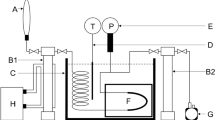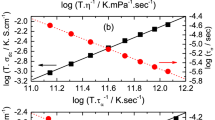Abstract
Complex dielectric response measurements have been made on a C60/C70 mixture pellet. The frequency and temperature ranges cover from 20 Hz to 1 MHz and from 30 to 300 K. Results show that the real part of the dielectric constant is 5 with a weak thermally activated polarization contribution. This thermal polarization is believed to be related to reorientation of C60 molecules recently observed by many techniques such as NMR, sound velocity, thermal conductivity, and others. Our data yield relaxation frequencies for reorientation, indicating that the presence of an additional electric dipole moment of the orientationally ordered C60 molecules at low temperature contributes 0.2–0.3 to the static dielectric constant.
Similar content being viewed by others
References
H. W. Kroto, J. R. Heath, S. C. O'Brien, R. F. Curl, and R. E. Smalley,Nature (London) 318, 162 (1985).
See, for example, D. R. Huffman,Physics Today, November 1991, 20, and references therein.
W. Kratschmer, K. Fostiropoulos, and D. R. Huffmann,Chem. Phys. Lett. 170, 167 (1990).
M. J. Rosseinsky, A. P. Ramirez, S. H. Glarum, D. W. Murphy, R. C. Haddon, A. F. Hebard, T. T. M. Palstra, A. R. Kortan, S. M. Zahurak, and A. V. Makhija,Phys. Rev. Lett. 66, 2830 (1991).
R. J. Meilunas, R. P. H. Chang, Shengzhong Liu, and Manfred M. Kappes,Appl. Phys. Lett. 59, 3461 (1991).
A. F. Hebard, R. C. Haddon, R. M. Fleming, and A. R. Kortan,Appl. Phys. Lett. 59, 2109 (1991).
P. L. Hansen, P. J. Fallon, and W. Kratachmer,Chem. Phys. Lett. 181, 367 (1991).
S. L. Ren, Y. Wang, A. M. Rao, E. McRae, J. M. Holden, T. Hager, Kai An Wang, Wen-Tse Lee, H. F. Ni, J. Selegue, and P. C. Eklund,Appl. Phys. Lett. 59, 2678 (1991).
C. S. Yannoni, R. D. Johnson, G. Meijer, D. S. Bethune, and J. R. SalemJ. Phys. Chem. 95, 9 (1991).
R. Tycko, G. Dabbagh, R. M. Fleming, R. C. Haddon, A. V. Makhija, and S. M. Zahurak,Phys. Rev. Lett. 67, 1886 (1991).
P. A. Heiney, J. E. Fischer, A. R. McGhie, W. J. Romanow, A. M. Denenstein, J. P. McCauley, and A. B. Smith,Phys. Rev. Lett. 66, 2911 (1991).
A. R. von Hippel,Dielectrics and Waves (Wiley, New York, 1954). Our data are not consistent with a single relaxation time but may provide evidence of a range of τ's.
Our estimate of Δɛ′(=ɛ′s−ɛ′∞) is based on the observed change in the peak and a rough correction for it, since the full relaxation range inω(ωτ « 1 toωτ » 1) has not been measured.
See, for example, J. Cioslowski and E. D. Fleischmann,J. Chem. Phys. 94, 3730 (1991); J. Cioslowski,J. Am. Chem. Soc. 113, 4139 (1991).
Author information
Authors and Affiliations
Additional information
We wish to thank William Jenks and Chris Rey for their assistance and advice in performing the measurements. We appreciate helpful discussions with E. Manousakis and J. Cioslowski. One of us (G.C.) acknowledges the support by the National Science Council of R.O.C. under grant No. NSC82-0208-M-194-030.
Rights and permissions
About this article
Cite this article
Chern, G., Mathias, H., Testardi, L.R. et al. Low-frequency dielectric permittivity of C60 . J Supercond 8, 207–210 (1995). https://doi.org/10.1007/BF00732372
Received:
Issue Date:
DOI: https://doi.org/10.1007/BF00732372




